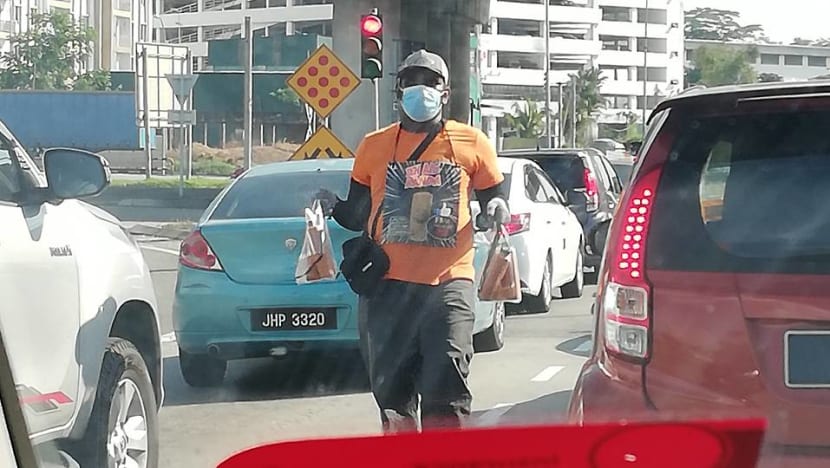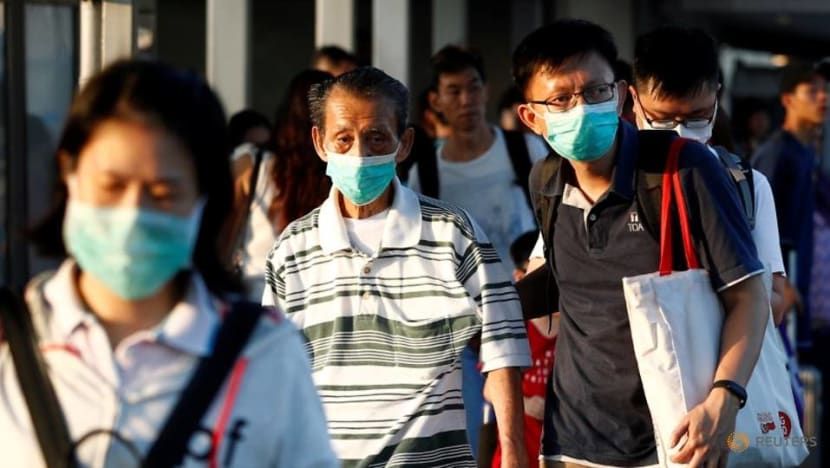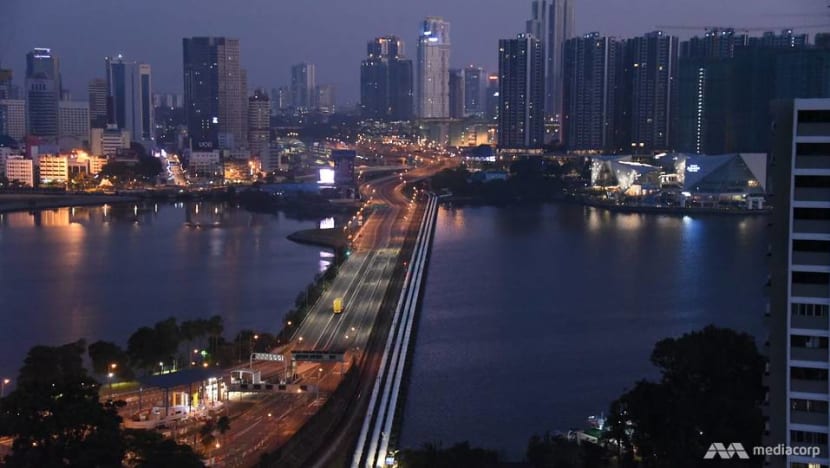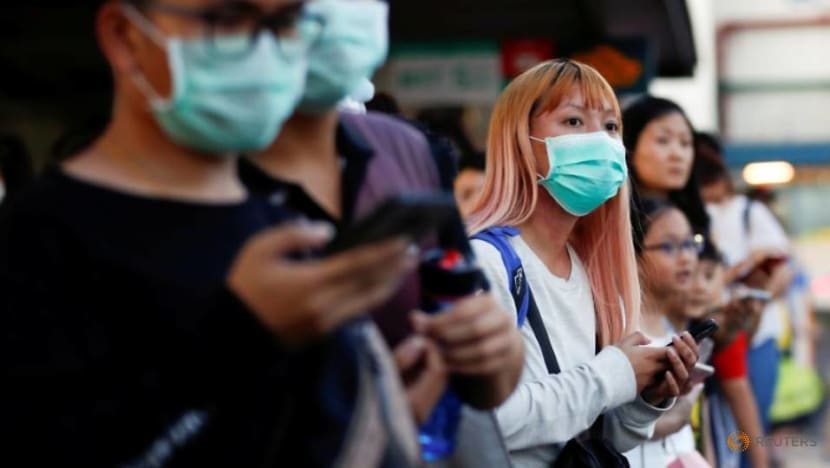commentary Commentary
Commentary: The former Malaysian workers in Singapore caught in limbo in Johor
Many Malaysian workers who used to work in Singapore have returned to Johor – and are struggling to find new ways to support themselves and their families, says ISEAS-Yusof Ishak’s Serina Rahman.

A Malaysian who used to work in Singapore selling drinks in Kempas, Johor Bahru. (Photo: Serina Rahman)
JOHOR: “I have been working in Singapore for 17 years, but now I cannot go in ... Selling durian is the only way I can earn money for now," a man selling fruit in a car park in Gelang Patah told me.
“We used to work in Singapore as cleaners, but now we have to wait until the border opens for us. So we sell what we can at the traffic lights. It’s a new idea – I’ve seen people do this in other countries on YouTube – people are always thirsty in the car,” another man who sold drinks at a traffic junction in Johor Bahru mentioned in the course of my field work.
Times are tough for Malaysian workers who used to work in Singapore but have returned to Johor since the movement control order (MCO) was imposed.
But things may be looking up for stranded professionals cut off from their traditional sources of employment across the Johor Strait.
In less than a week, travel between Singapore and Malaysia will restart for business and official purposes under the Reciprocal Green Lane arrangement.
LISTEN: What next for Malaysian workers stuck there and Singapore businesses who hire them here?
READ: Commentary - Paying the price of progress requires a new growth strategy
There are measures in place to control the risk of COVID-19 spread. Visitors must still take swab tests before departure and upon arrival, and stick to a controlled itinerary for 14 days for example.
Unfortunately, this arrangement does not apply to the 100,000 Malaysian workers who previously commuted daily into Singapore and headed home across the Causeway after.
Some may consider the Periodic Commuting Arrangement, which allows Singapore and Malaysia citizens or permanent residents (PRs) who hold long-term immigration passes for business purposes in the other country to enter that country for work and return for home leave every 90 days.
But with additional costs and responsibilities imposed on employers to ensure employees comply with regulations, some firms and Malaysian workers in Singapore are hesitant, given this uncertain economic climate.
THE DAILY COMMUTER FROM MALAYSIA
Singaporeans might think of Malaysian workers as part of the foreign workforce pool yet the Malaysian worker in Singapore is hardly distinguishable from a Singaporean.

Malaysians have found jobs and niches in all levels of employment. Many have married Singaporeans and made Singapore home. About a million Malaysians live in Singapore, as PRs, work pass holders and more.
Of those who make the daily commute, most work in blue-collar jobs; in factories, F&B, sales and services, as well as as hairdressers, cleaners, technicians, mechanics, electricians, plumbers and builders – to name a few.
Working from home is rarely an option for this labour force who work with their hands, while staying in Singapore for an extended period adds costs to a limited income.
This group have been affected the most by coronavirus-induced border closures, with most left in limbo on either side of the Causeway, dealing with employment uncertainty.
READ: Commentary: Burned out while working from home? You should check your work-life boundaries
READ: Commentary: The Philippines hopes lockdown buys time after half-hearted attempts at tackling COVID-19
WHY DO THEY COMMUTE?
A daily commuter’s journey usually begins before dawn, with the morning trip into Singapore usually by bus or motorbike taking anywhere between one-and-a-half to three hours depending on where a commuter lives, the day of the week, traffic conditions and sheer luck.
The return trip often stretches well into the night. As someone who used to make that daily expedition, it is a long and exhausting journey. Most get used to it after a while, but it leaves little time to be at home with family.
Malaysians commute because of the Singapore dollar value. An income multiplied by three is a big draw, and has enabled many who take up the challenge to inch into the middle income bracket, buy houses and cars and comfortably support their families.
For others, working in Singapore offers unrivalled opportunities - international networks, broader horizons, efficient working conditions and positive additions to a CV. Many cite the lack of available employment with competitive remuneration in Malaysia.

For a worker with a secondary school education earning RM750 (S$245) as a cleaner in Malaysia, it makes more sense to take up that role in Singapore, which can fetch multiple times more – a huge difference if saving for a wedding, starting a new family or supporting elderly parents.
STRANDED IN SINGAPORE
When the borders closed in March, all this screeched to a halt. For the first time ever, the busiest border crossing in the world fell eerily silent.
On the day before they shut the border, commuters (myself included) scrambled to grab belongings and either find accommodation in Singapore to hunker down for what we initially thought might be a two-week closure or make arrangements to return to Malaysia.
Firms like SBS Transit and NTUC Fairprice as well as charities and Singapore households opened up places for Malaysians who decided to stay. Employers were provided S$50 a night for each worker to aid with accommodation costs.
But some who opted to remain in Singapore found themselves out of work as Singapore buckled down for its circuit breaker.
READ: Commentary - The circuit breaker was a time many of us want to forget. Let’s make it count
READ: Commentary - Support for mid-career jobseekers is welcomed. But expectations need to be managed
Reports of Malaysians stranded and sleeping on the streets also emerged, along with stories of those unable to return home during family tragedies.
Thankfully, Malaysia began to allow up to 400 stranded citizens to return per day in April. Those able to do so had to walk across the bridges connecting the two nations, given that other transportation options had ceased, and spend time in government quarantine centres.
COPING WITH UNEMPLOYMENT IN JOHOR
With movement restriction orders in place and national economies almost slowed to a halt, commuters who returned to Malaysia struggled to make ends meet.
But when push comes to shove, Malaysians will find new ways to eke out a living.
Interviews with those who sold fruit from their cars or snacks and drinks at traffic lights around Johor Bahru mentioned they worked in Singapore for many years, but had to now find alternatives to feed their families. Several became food delivery riders.

Malaysian employers were reluctant to hire those who used to work in Singapore. They expected them to quit when the borders reopened. Job hunters have confessed this is a likely scenario.
As the weeks turned into months, home businesses and food trucks mushroomed as many resigned themselves to the realisation that they might not be able to return to Singapore until 2021.
Many who had rented accommodation in Johor Bahru to commute into Singapore pre-coronavirus gave these up to return to their hometowns and villages once interstate travel was permitted.
Some who have seen the despair of those unable to return to Malaysia after the passing of a partner, child or parent readjusted their expectations and standards of living – opting to be close to family.
LIVING WITH THE COVID-19 SITUATION
The mental health impacts of separation, forced unemployment and the total change in lifestyle of those who used to commute for work need to be looked into. Malaysia’s National Fire and Rescue Department has reported that the attempted suicide incidents they attend to have spiked since the MCO was imposed.
They expect actual numbers to be far higher and cite financial distress as a key reason for people attempting suicide.
READ: Commentary - Decriminalising attempted suicide in Singapore does not mean less help for vulnerable people
READ: Commentary - As therapy sessions move online, more may finally seek needed help
The full economic blowback will be clearer once Malaysian banks lift debt moratoriums in September. The Johor state government reported in April that more than 15,000 employees in Johor were retrenched or faced salary cuts over the MCO period.
This is a small percentage of the more than 60,000 nationwide who lost jobs, which Malaysia’s Human Resource Minister M Saravanan highlighted in end-July, but it is unclear if this second set of figures includes returning workers from Singapore and those relying on home-based micro-businesses.
Targeted assistance under the Malaysian government’s economic recovery plans and stimulus packages Penjana and Prihatin plans are not accessible to Malaysian workers who have only worked in Singapore and do not contribute to Malaysia’s Employment Provident Fund.

Plans to revive rural economies and agricultural-based employment may be less relevant to this group.
Even though we are divided by national borders, Singapore and Malaysia remain very much closely intertwined culturally, socially and economically.
Leaders from both sides know this. Johor's Chief Minister Hasni Mohammad welcomed the move to allow Malaysians to commute from Johor Bahru to Singapore for work in June when it was first announced, adding this would not only provide relief for workers but would also help to boost the economy in both countries.
While borders are slated to reopen, we are a long way from old norms that reinforced this complex interdependency between Singapore and Malaysia.
Until a way can be found for daily commuters to travel safely between the nations, both countries will have to work out a way to cope with the economic impact to Singapore firms and those dedicated Malaysian workers looking for a job.
READ: With due dates looming and COVID-19 curbs, Malaysian expectant mums in Singapore faced with hard choices
BOOKMARK THIS: Our comprehensive coverage of the coronavirus outbreak and its developments
Download our app or subscribe to our Telegram channel for the latest updates on the COVID-19 outbreak: https://cna.asia/telegram
Dr Serina Abdul Rahman is a Visiting Fellow at the ISEAS – Yusof Ishak Institute.














